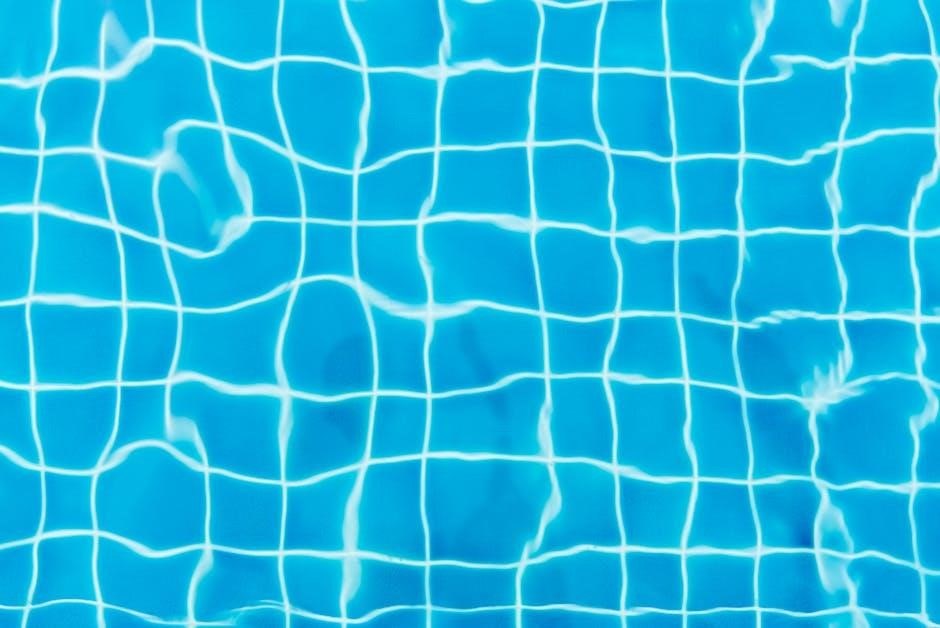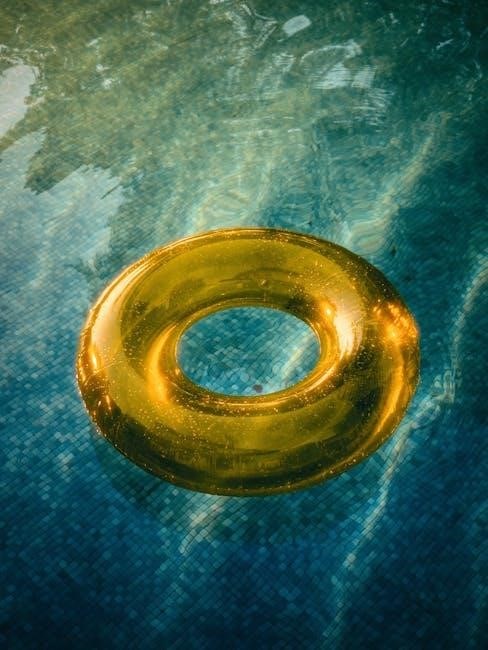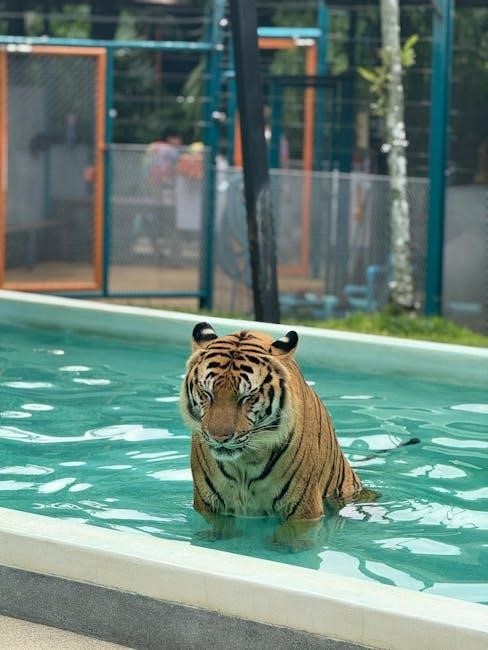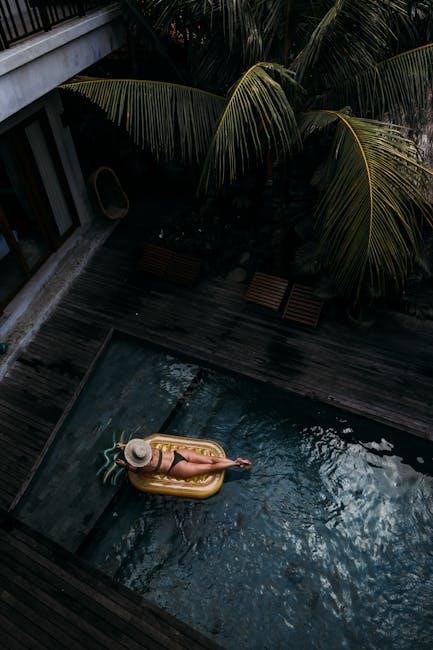Discover essential steps for installing and maintaining your Intex pool pump to ensure clean water and safe swimming conditions. This guide covers setup, operation, and care tips.
1.1 Overview of Intex Pool Pumps
Intex pool pumps are essential for maintaining clean and clear water in above-ground pools. They work by circulating water through a filter, removing impurities and improving water clarity. Available in cartridge and sand filter models, these pumps are designed for compatibility with Intex pool sets, such as Easy Set, Metal Frame, and Prism Frame pools. With varying GPH (gallons per hour) ratings, they cater to different pool sizes, ensuring efficient filtration and circulation. Their compact design and user-friendly operation make them a practical choice for pool owners seeking hassle-free maintenance and enjoyable swimming experiences.
1.2 Importance of Proper Installation and Maintenance
Proper installation and maintenance of your Intex pool pump are crucial for optimal performance, safety, and longevity. Incorrect setup can lead to mechanical issues, poor water circulation, and even electrical hazards. Regular tasks like cleaning the filter, inspecting hoses, and ensuring tight connections prevent malfunctions and extend the pump’s lifespan. Neglecting maintenance can result in reduced efficiency, cloudy water, and potential system damage. By following the manufacturer’s guidelines and performing routine checks, you ensure a safe, clean, and enjoyable swimming environment while protecting your investment in the pool and pump system.
Choosing the Right Intex Pool Pump for Your Pool
Selecting the right Intex pool pump ensures efficient water circulation and filtration. Consider pool size, type, and GPH rating to find the perfect fit for your needs.
2.1 Understanding Pool Size and Pump Compatibility
Matching the right Intex pool pump to your pool size is crucial for efficient water circulation and filtration. Intex offers pumps compatible with various pool models, including Easy Set, Metal Frame, and Prism Frame pools. Consider the pool’s gallon capacity and the pump’s GPH (gallons per hour) rating to ensure proper flow. For example, smaller pools may require a 330 GPH pump, while larger ones need up to 4000 GPH. Correct sizing ensures optimal performance and prevents issues like low water flow or inadequate filtration.
2.2 Types of Intex Pool Pumps (Cartridge vs. Sand Filter)
Intex offers two primary types of pool pumps: cartridge and sand filters. Cartridge pumps are ideal for smaller pools, using replaceable filter cartridges for easy maintenance. Sand filters, like the Krystal Clear series, are suitable for larger pools, providing improved circulation and filtration with sand as the filtering medium. Both types include necessary hoses and connections, ensuring a straightforward setup. Choosing the right type depends on your pool size and maintenance preferences, with sand filters offering longer-lasting filtration and cartridge pumps providing simplicity and convenience.
2.3 Selecting the Correct GPH (Gallons Per Hour) Rating
Selecting the right GPH rating for your Intex pool pump is crucial for efficient water circulation and filtration. The GPH rating must match your pool’s size and type, ensuring proper water turnover. For example, the Intex SX1500 sand filter pump offers 1,500 GPH, suitable for larger pools, while smaller pools may require lower GPH models like 330 or 530 GPH cartridge pumps. Choosing the wrong GPH can lead to poor water clarity or increased energy costs. Always consult the user manual for specific recommendations based on your pool’s capacity and configuration.

Unboxing and Preparing the Intex Pool Pump
Unboxing and preparing your Intex pool pump involves checking all components, understanding each part, and ensuring the pool area is ready for installation.
3.1 Checking the Contents of the Box
Upon unboxing your Intex pool pump, verify all components are included. This typically includes the pump unit, hoses, filter cartridge or sand filter, clamps, and user manual. Ensure no items are damaged or missing. Check for additional accessories like adapters or valves, depending on your model. Familiarize yourself with each part to understand its purpose. Having all components ready ensures a smooth installation process. If anything is missing or damaged, contact customer support immediately to resolve the issue before proceeding.
3.2 Understanding the Components (Hoses, Filters, etc.)
Familiarize yourself with the components included with your Intex pool pump. The hoses connect the pump to the pool, ensuring water circulation. The filter, either a cartridge or sand type, cleans the water by trapping dirt and debris. Additional parts like clamps and adapters secure connections and ensure a proper fit. For cartridge models, a pre-installed filter cartridge is usually provided. Understanding each component’s function is crucial for correct installation and maintenance. Take time to inspect and organize all parts before starting the setup process to avoid confusion later.
3.3 Preparing the Pool Area for Pump Installation
Before installing your Intex pool pump, ensure the pool area is clear of debris and obstructions. The pool must be on level ground to function properly. Check that the surface where the pump will sit is stable and dry to prevent any damage or accidental movement. Ensure all necessary accessories, such as hoses and filters, are within reach. Additionally, verify that the pool’s inlet and outlet fittings are correctly positioned and free from blockages. A well-prepared area will simplify the installation process and ensure optimal pump performance.
Pre-Installation Steps
Ensure the pool is on level ground, position the pump correctly, and read the manual thoroughly to guarantee a safe and effective installation process.
4.1 Ensuring the Pool is on Level Ground
Before installing the Intex pool pump, ensure your pool is on level ground to prevent structural issues and ensure proper water distribution. Use a spirit level to check the pool’s base. If uneven, adjust the ground or use sand or plywood to create a stable surface. Proper leveling ensures the pump operates efficiently and avoids potential damage from uneven pressure. This step is crucial for safe and effective pool functionality.
4.2 Positioning the Pump Correctly
Place the Intex pool pump on a flat, stable surface near the pool, ensuring it is at the same level as the pool’s water base. Position it at least 10 feet away from the pool to allow proper circulation and minimize noise. Avoid direct sunlight and moisture-prone areas. The pump should be accessible for maintenance and protected from debris. Correct positioning ensures optimal performance, reduces wear, and prevents hazards. Always follow the manufacturer’s guidelines for pump placement to maximize efficiency and safety.
4.3 Reading the User Manual Thoroughly
Reading the user manual thoroughly is crucial for proper installation and operation of your Intex pool pump. The manual provides detailed instructions, safety precautions, and troubleshooting tips specific to your pump model. Pay attention to sections on electrical connections, filter maintenance, and GFCI protection. Familiarize yourself with diagrams and parts lists to ensure correct assembly. Highlight key steps like priming the pump and setting the timer. Following the manual closely helps prevent errors, ensures safety, and prolongs the pump’s lifespan. Keep the manual handy for future reference and troubleshooting.
Installing the Intex Pool Pump
Install your Intex pool pump by connecting hoses, attaching the filter, and placing the pump on level ground. Ensure all connections are secure and test the system for leaks.
5.1 Connecting the Hoses to the Pump and Pool
Connect the hoses to both the pump and pool, ensuring they are securely attached; Use the provided clamps to tighten connections firmly. Make sure hoses are free from kinks and blockages. Refer to the user manual for specific hose length and type recommendations. Properly align the intake and return valves to maintain efficient water flow. Double-check all connections for tightness to prevent leaks. Ensure the pump is placed on level ground before connecting hoses to avoid uneven water distribution. Follow the manufacturer’s guidelines for optimal performance and safety.
5.2 Attaching the Filter Cartridge or Sand Filter
Attach the filter cartridge or sand filter to the pump as specified in the manual. For cartridge filters, remove any protective wrapping and insert the cartridge into the housing until it clicks. Secure the housing tightly. For sand filters, ensure the sand is at the recommended level and the multiport valve is set correctly. Double-check that all connections are sealed properly to prevent leaks. After installation, test the system by running the pump briefly to ensure smooth operation and even water circulation.
5.3 Placing the Pump in the Correct Location
Place the Intex pool pump on a level, stable surface near the pool to ensure proper water circulation. Position it slightly elevated to prevent water from accumulating around the base. Keep the pump at least 10 feet away from the pool edge to avoid interference with swimmers. Ensure the area is well-ventilated and away from windows or doors to prevent electrical hazards. Follow the manufacturer’s guidelines for optimal placement, as outlined in the user manual, to maintain efficiency and safety.
5.4 Testing the Pump for Proper Functionality
After installation, turn on the pump and observe its operation. Check the water flow rate to ensure it matches the specified GPH. Verify that water circulates evenly and the filter cleans effectively. Listen for unusual noises, which may indicate improper installation or blockages. Ensure the pump priming process is complete and air is purged from the system. Monitor the pool’s water clarity over time to confirm the pump is functioning correctly. Address any issues promptly to maintain optimal performance and extend the pump’s lifespan.
5.5 Checking for Leaks and Tightening Connections
Inspect all connections, including hoses, valves, and the filter, for any signs of leaks. Run the pump briefly and visually check for water seeping from joints or fittings. Tighten any loose connections firmly but avoid over-tightening, which could damage threads. Ensure the pump and pool are on level ground to prevent uneven stress on connections. If leaks persist, consult the user manual or consider replacing worn-out seals. Properly secured connections are crucial for efficient operation and longevity of the Intex pool pump system.

Operating the Intex Pool Pump
Start by turning on the pump and adjusting the flow rate as needed. Monitor water clarity and circulation to ensure optimal performance and clean swimming conditions.
6.1 Turning On the Pump for the First Time
Before turning on the pump, ensure all connections are secure and the filter cartridge is properly installed. Plug the pump into a GFCI-protected outlet and press the power button. Allow the pump to prime and start circulating water. Monitor for any leaks or unusual noises. If the pump doesn’t turn on, check the power source and connections. Once operational, adjust the flow rate as needed for optimal water clarity and circulation. Regularly inspect the system to ensure smooth operation and address any issues promptly to maintain your pool’s cleanliness and safety.
6.2 Understanding the Pump’s Flow Rate and Settings
Understanding your Intex pool pump’s flow rate and settings is crucial for optimal performance. The flow rate, measured in gallons per hour (GPH), determines how quickly water circulates. Ensure the pump’s GPH matches your pool’s size for efficient filtration. Adjust the settings according to your pool’s needs, such as increasing flow for heavier use. Refer to the user manual for specific guidance on configuring the pump’s settings. Proper adjustment ensures clear water, balanced circulation, and extends the pump’s lifespan. Regularly monitor and adjust settings to maintain peak performance and prevent overworking the motor.
6.3 Monitoring the Pool’s Water Clarity and Circulation
Regularly monitor the pool’s water clarity and circulation to ensure optimal performance. Clear water indicates effective filtration, while cloudy water may signal a clogged filter or improper flow. Check circulation by observing water movement and ensuring all areas receive adequate flow. Adjust the pump’s settings if necessary to maintain clarity and even distribution. Proper monitoring prevents algae growth and maintains a safe swimming environment; Use test strips to measure chemical levels and ensure the pump operates within recommended parameters for consistent water quality.
Maintaining the Intex Pool Pump
Regular cleaning of the filter cartridge and hoses is essential for optimal performance. Replace the cartridge as needed and lubricate moving parts to ensure proper functionality and extend pump life.
7.1 Cleaning the Filter Cartridge or Sand Filter
Regular maintenance ensures optimal performance. For cartridge filters, rinse with a garden hose to remove debris. Avoid using harsh chemicals or abrasive cleaners. Sand filters require backwashing by reversing water flow to flush out dirt. Replace sand every few seasons. Check the manufacturer’s guidelines for specific instructions. Cleaning frequency depends on usage, but typically every 1-2 weeks is recommended. Proper maintenance prevents clogging, improves water circulation, and extends the pump’s lifespan. Always turn off the pump before cleaning to avoid damage or injury.
7.2 Replacing the Filter Cartridge as Needed
Turn off the pump and ensure the area is safe. Locate the filter cartridge, typically inside the pump. Remove any clips or screws to access it. Inspect the old cartridge for dirt and consider cleaning or replacing it. Purchase a compatible replacement cartridge from Intex or an authorized seller. Install the new cartridge securely, ensuring it fits properly. After installation, run the pump briefly to check for leaks or unusual noises. Regular replacement, typically every few weeks during heavy use, helps maintain water quality and pump efficiency. Set reminders to stay on schedule and refer to detailed guides or videos if needed. Proper maintenance will keep your pool water clean and clear, extending the pump’s lifespan.
7.3 Lubricating Moving Parts (if applicable)
Lubricating moving parts of your Intex pool pump ensures smooth operation and prevents wear. Check the manual to identify parts needing lubrication, such as seals or gaskets. Use a silicone-based lubricant suitable for pool equipment to avoid chemical reactions. Apply a small amount to moving components and wipe off excess. Avoid petroleum-based products, as they can damage rubber parts. Regular lubrication enhances pump efficiency and extends its lifespan. Perform this maintenance every few months or as recommended to keep your pump running optimally and maintain clean, safe pool water.
7.4 Regularly Inspecting Hoses and Connections
Regularly inspecting the hoses and connections of your Intex pool pump is crucial for maintaining proper function. Check for cracks, leaks, or loose connections, which can reduce efficiency or lead to damage. Tighten any loose fittings and replace worn-out gaskets or seals. Ensure hoses are securely attached to both the pump and pool. Inspect the O-rings and valve connections for signs of wear. Addressing issues promptly prevents water loss and maintains optimal water circulation. This simple maintenance step helps extend the lifespan of your pump and keeps your pool clean and safe for swimming.

Winterizing the Intex Pool Pump
Drain the pump and hoses, store them in a dry place, and protect from freezing temperatures to maintain functionality and longevity during the off-season.
8.1 Draining the Pump and Hoses
To winterize your Intex pool pump, start by turning it off and disconnecting the power source. Remove the drain cap and allow the pump and hoses to drain completely. For cartridge models, take out the filter and rinse it thoroughly. For sand filters, ensure all water is drained from the tank. Clean the strainer grid and hose connections to remove debris. Store the drained components in a dry, protected area to prevent freezing. Always refer to your specific model’s manual for detailed draining instructions.
8.2 Storing the Pump and Accessories Properly
After draining, clean the pump and accessories thoroughly. Dry all components to prevent mold or mildew. Store the pump, hoses, and filters in their original packaging or a protective cover. Keep them in a dry, cool place away from direct sunlight and freezing temperatures. Avoid stacking heavy objects on the pump or hoses. Inspect for any damage before storage and replace worn parts if necessary. Proper storage ensures your Intex pool pump remains functional and ready for the next swimming season.
8.3 Protecting the Pump from Freezing Temperatures
Drain all water from the pump, hoses, and filter to prevent ice damage. Use a non-toxic propylene glycol antifreeze if needed, but never automotive antifreeze. Store the pump in a climate-controlled area or insulated shed. Keep it off the ground to avoid moisture. Cover the pump with a protective layer to shield it from cold air. Freezing can crack internal components, so thorough preparation is crucial for maintaining your Intex pool pump’s longevity and functionality during winter months.

Safety Precautions and Best Practices
Ensure safe operation by avoiding electrical hazards and keeping the area well-ventilated. Keep children and pets away from the pump to prevent accidents and injuries. Always follow the manufacturer’s guidelines for installation, maintenance, and operation to ensure optimal performance and longevity of your Intex pool pump. Regular inspections and proper storage during off-season are also crucial for maintaining safety and functionality. By adhering to these precautions, you can enjoy a clean and safe swimming experience throughout the year.
9.1 Avoiding Electrical Hazards
To ensure safe operation, always keep the Intex pool pump away from water when plugged in. Use a Ground Fault Circuit Interrupter (GFCI) protected outlet to prevent electric shock. Avoid using damaged cords or loose connections, as they can cause electrical hazards. Never submerge the pump or expose it to rain. Ensure proper ventilation around the pump to avoid moisture buildup. Turn off the pump before performing any maintenance. Keep children and pets away from electrical components. Following these guidelines will help prevent accidents and ensure a safe swimming environment.
9.2 Ensuring Proper Ventilation Around the Pump
Proper ventilation around the Intex pool pump is crucial to prevent moisture buildup and ensure efficient operation. Keep the pump in a well-ventilated area, away from flammable materials. Regularly inspect the surrounding space to ensure no debris or obstructions block airflow. Proper ventilation helps reduce the risk of electrical issues and prolongs the pump’s lifespan. Always maintain a safe distance from walls or structures to allow air to circulate freely. This simple step contributes significantly to the pump’s performance and safety.
9.3 Keeping Children and Pets Away from the Pump
Keeping children and pets away from the Intex pool pump is essential for their safety and the pump’s proper function. The pump contains electrical components and moving parts that can pose hazards if tampered with. Supervise children and pets near the pool area and consider installing barriers to restrict access. This prevents accidental damage to the pump and ensures safe operation. Regularly inspect the pump’s surroundings to ensure no toys or objects are nearby that could interfere with its function or create safety risks;

Troubleshooting Common Issues
Troubleshooting common issues with your Intex pool pump is crucial for maintaining optimal performance. Address problems like low water flow, pump not starting, or leaks promptly to ensure efficient operation.
10.1 Low Water Flow or Pressure
Low water flow or pressure in your Intex pool pump can be caused by clogged filters, kinked hoses, or improper pump sizing. To resolve this, first, inspect and clean the filter cartridge or sand filter. Check hoses for kinks or blockages and ensure they are securely connected. Verify that the pump is appropriately sized for your pool volume. Additionally, ensure all valves are fully open and not restricting water flow. Regular maintenance, such as cleaning the filter and inspecting hoses, can prevent these issues and maintain optimal water circulation.
10.2 Pump Not Turning On
If your Intex pool pump fails to turn on, check the power source first. Ensure the pump is properly plugged into a GFCI-protected outlet and that no circuit breakers have tripped. Verify that all connections are secure and that the pump is correctly assembled. Consult the user manual to ensure the pump is installed according to specifications. If issues persist, inspect for internal component damage or malfunction. Contact customer support if the problem remains unresolved after basic troubleshooting steps. Always follow safety guidelines when diagnosing electrical issues.
10.3 Leaks in the System
If you notice leaks in your Intex pool pump system, start by turning off the pump and inspecting all connections. Check the hoses, clamps, and gaskets for signs of damage or wear. Tighten any loose connections and replace damaged seals or gaskets. Ensure the filter cartridge or sand filter is properly installed and clean. If leaks persist, consult the user manual for specific troubleshooting steps or contact customer support for assistance. Regular maintenance can help prevent future leaks and maintain system efficiency.
Proper installation and regular maintenance ensure optimal performance. Follow safety guidelines and store equipment correctly during off-seasons to enjoy a clean, safe, and long-lasting pool experience.
11.1 Summary of Key Steps
Ensure your Intex pool pump is installed on level ground, securely connected to the pool, and equipped with the correct filter type. Regularly clean or replace the filter, check for leaks, and store the pump properly during winter. Follow the user manual for specific instructions, and maintain a safe environment by keeping children and pets away. By adhering to these steps, you’ll enjoy a well-functioning pump, clear water, and a safe swimming experience throughout the season.
11.2 Importance of Regular Maintenance
Regular maintenance is crucial for extending the lifespan of your Intex pool pump and ensuring optimal performance. Cleaning the filter cartridge or sand filter prevents clogs and maintains water clarity. Inspecting hoses and connections for leaks and wear can prevent costly repairs. Lubricating moving parts and winterizing the pump protect it from damage. Consistent upkeep not only keeps your pool clean but also ensures the pump operates efficiently, saving energy and reducing the risk of mechanical failures over time.
11.3 Enjoying Your Clean and Safe Pool
With your Intex pool pump properly installed and maintained, you can enjoy a clean and safe swimming environment. Regular maintenance ensures clear water, optimal circulation, and a healthy swimming space. By following the guidelines, you’ll prolong the pump’s lifespan and keep energy costs low. A well-maintained pool enhances your recreational experience, providing endless hours of fun and relaxation for you and your family. Remember, a clean pool is not only visually appealing but also essential for the health and safety of everyone who uses it.
